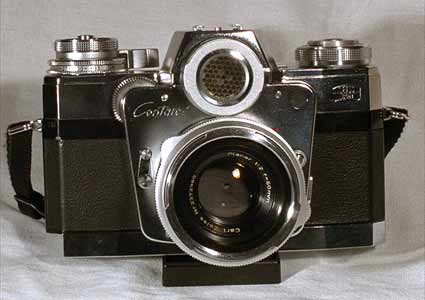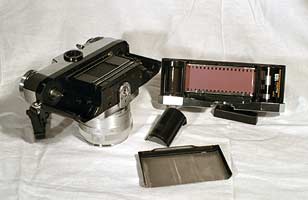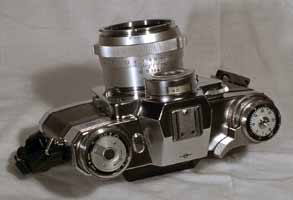
 I sat down with the camera body and after two hours and some micro-surgery on a spring which had disconnected itself at one end, I had the aperture lever inside the bayonet stop down the lenses again. Pheeewww....
I sat down with the camera body and after two hours and some micro-surgery on a spring which had disconnected itself at one end, I had the aperture lever inside the bayonet stop down the lenses again. Pheeewww....
The shutter was later taken care of by Gima GmbH of Munich, a repair service specialized in Zeiss Ikon equipment, together with a complete CLA of the camera body.
Some History
The Contarex I was first shown at the 1958 Photokina and became available in early 1960 for a hefty 1,060 deutschemarks including the 2.0/50 mm Carl Zeiss Planar standard lens. In those days, the price of a two-pound loaf of bread was 1 DM, a tram ticket was 0.50 DM, and my parents paid a rent of 80 DM per month! Makes a Nikon F5 look like a real bargain.
Some 32,000 of the original 'Bullseye' or 'Cyclops' were made until 1966 and, together with the later models, contributed a lot to a growing financial deficit which eventually led to the end of all Zeiss Ikon camera production, in 1971.
Technical aspects
There are a few characteristics which differ so much from today's SLRs that they deserve an explanation. The most prominent feature certainly is the lightmeter which has earned this camera its nickname. Ironically, TTL metering should be pioneered by the estranged Eastern relatives at Dresden.
One of the many novelties with this design was the cross-coupling between the speed and aperture settings and the exposure meter. It does, however, work a little different from the more modern versions and this also explains why Contarex lenses have no aperture control ring. The aperture is set by a small knurled wheel at the front of the camera body which is geared to a second iris in front of the exposure meter's selenium cell. Thus, the amount of light reaching the meter is directly linked to the pre-selected lens aperture. A potentiometer under the speed dial provides the speed information for the light meter and completes the circuit.
The most practical thing by far about a Contarex are the backs. Like with some medium format cameras, they can be swapped in mid-roll without having to rewind the film or losing a single frame. A system of interlocks prevents accidents like taking off a magazine without closing it first. They can be changed in a matter of seconds. During a recent holiday on Mallorca, in late November, the days were short but very bright, there were a number of beautiful shots to be taken around dusk and dawn, I did a lot of nighttime shooting at the Soller tram depot, and I like B/W, as well. Four mags loaded with Supra 100, 400, and 800, plus one with XP-2 made sure that everything could be done with exactly the right film.
The very bright viewfinder has been realized by means of a fresnel lens instead of the more common matte screen. The disadvantage of this is that there is no DOF preview and no way of focussing just anywhere on the screen without using the split field and micro-prism focussing aids.
To complete the description of the camera body, here's a quick run-down of the key features and specifications:

- shutter speeds from 1 to 1/1000 sec plus B
- focal plane shutter
- instant -return mirror
- focussing at full aperture
- exchangeable backs
- wide choice of accessories for scientific and macro photography
- 'data strips' for including written data on the negative
- exchangeable focussing screens with the later 'D' series
- dimensions with Planar lens (whd): 155 x 100 x 105 mm
- weight with Planar lens: 1,300 g (3 lbs !!!)
Am I happy with it? I'm happy with the picture quality it delivers. The workmanship is simply adorable. It's a beauty and the greatest working conversation piece I've ever had. On the downside, the ergonomics are a disaster by modern standards, and everything is so heavy that, in this household, my Tamrac bag with the body and the lenses plus a few backs and accessories goes by the name of 'The Millstone'. But those Zeiss lenses really are worth it all and I do love the exchangeable backs, an extremely rare feature for a 35 mm camera.